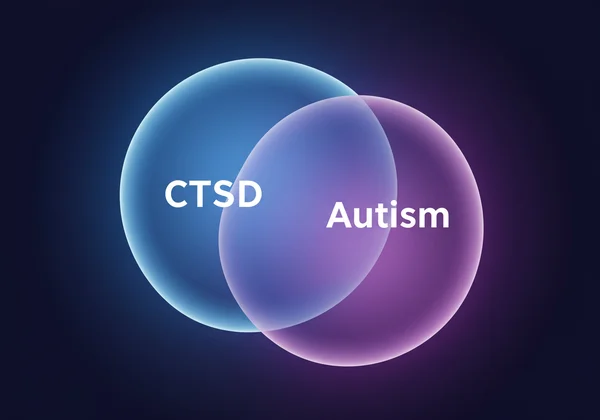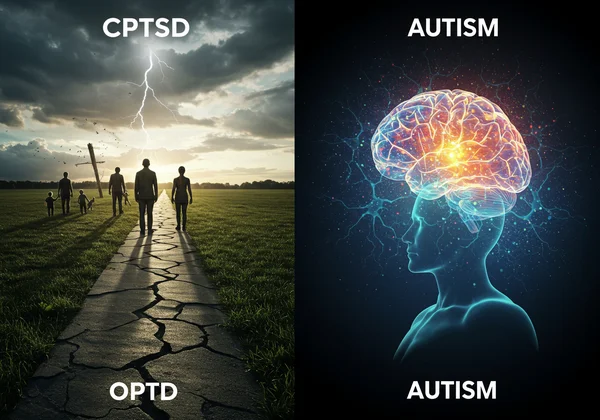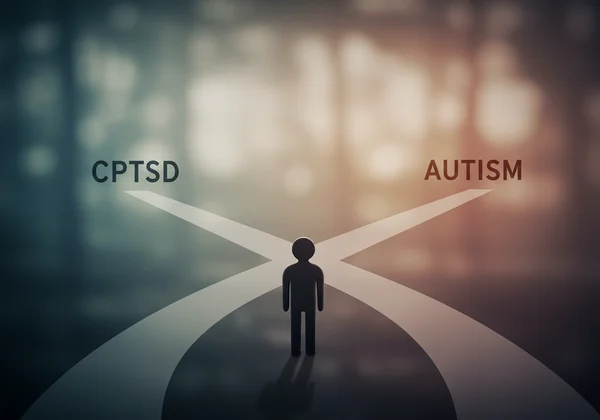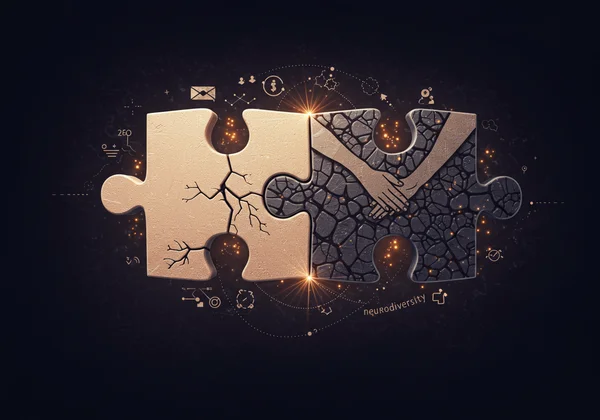CPTSD vs. Autism: Symptoms, Distinctions & Tests
Are you grappling with symptoms that feel like a puzzle, wondering if they point to Complex PTSD (CPTSD) or Autism Spectrum Disorder (ASD)? Many individuals experience overlapping traits like social difficulties, emotional dysregulation, and sensory sensitivities, leading to confusion and even misdiagnosis. If you are searching for answers, you are not alone. How can I tell if I have CPTSD or traits of autism? This guide will clarify the key distinctions and similarities, helping you understand your experiences and where to find clear answers. A helpful first step can be a reliable cptsd test to explore trauma-related symptoms.
This guide will provide clarity and support on your journey of self-discovery. Understanding the root of your experiences is a powerful act of self-compassion. If you feel ready to explore whether your symptoms align with CPTSD, you can start a free screening at any time.
CPTSD and Autism: Understanding the Overlap
At first glance, the presentations of CPTSD and Autism can look remarkably similar. This overlap is a primary source of confusion for individuals, families, and even clinicians. Recognizing these shared experiences is the first step toward untangling them and understanding what makes each condition unique. Both can significantly impact how you navigate the world, but they stem from very different origins.

Shared Traits: Social Difficulties & Emotional Dysregulation
One of the most significant areas of overlap lies in social interaction and emotional management. Both autistic individuals and those with CPTSD may find social situations draining and difficult to navigate. This can manifest as avoiding social gatherings, struggling to maintain relationships, or misinterpreting social cues.
For an autistic person, these challenges often stem from innate differences in social communication and processing. They might struggle with unwritten social rules or find eye contact uncomfortable. For someone with CPTSD, social difficulties are often rooted in trauma-related fears of betrayal, rejection, or harm. They may become hypervigilant, constantly scanning for threats, or withdraw to protect themselves from potential pain. Similarly, intense emotional responses, or emotional dysregulation, are common in both. This could look like sudden outbursts of anger or deep periods of sadness.
Sensory Sensitivities: A Closer Look at Shared Experiences
Sensory sensitivity is another key area where CPTSD and Autism can be confused. Many autistic individuals experience the world through a heightened sensory lens, where sounds can be painfully loud, lights overwhelmingly bright, and textures unbearable. This is a neurobiological part of how their brain processes sensory information from birth.
In CPTSD, sensory sensitivities are also common but are typically linked to trauma. A person with CPTSD might be extremely startled by loud noises because it triggers a fight-or-flight response connected to a past threat. Certain smells or sights could trigger emotional flashbacks, thrusting them back into the feelings of a traumatic event. While the outward reaction may seem identical—a strong aversion to a sensory stimulus—the internal mechanism is different.
Key Distinctions: Trauma-Informed vs. Neurodevelopmental Origins
The most crucial difference between CPTSD and Autism lies in their origins. This fundamental distinction shapes everything from the internal experience to the pathways for support and healing. One is an injury acquired through experience, while the other is an innate part of a person's neurological makeup. An online cptsd and autism test can help explore these differences from a symptom perspective.
The Genesis: Chronic Trauma vs. Innate Brain Differences
CPTSD is a trauma-based disorder. It does not exist without the experience of prolonged or repetitive trauma, such as childhood emotional neglect, domestic abuse, or long-term bullying. The symptoms are the mind and body's adaptations to surviving an environment that was consistently unsafe. The brain wires itself for survival in a threatening world.
Autism, on the other hand, is a neurodevelopmental condition. This means it originates from differences in brain development that are present from birth and persist throughout a person's life. It is not caused by trauma, parenting styles, or life experiences. Autism is a fundamental part of a person's identity and how they perceive and interact with the world.

Core Internal Experience: Fear & Shame vs. Social Communication Patterns
The internal, subjective experience of these conditions also differs greatly. For someone with CPTSD, the inner world is often dominated by a negative self-concept forged by trauma. Feelings of worthlessness, shame, and a sense that one is fundamentally flawed are core to the condition. There is often a persistent feeling of being unsafe, even when no threat is present.
For an autistic person, the core internal experience is not centered on shame or fear in the same way. Instead, their experience is shaped by a different way of processing information, communicating, and socializing. Challenges may arise from the friction of living in a world not designed for their neurotype, which can lead to anxiety or depression, but the root is one of difference, not damage. If you're looking to clarify these feelings, a complex ptsd test can offer initial insights.
Diagnostic Criteria: ICD-11 for CPTSD vs. DSM-5 for ASD
From a clinical perspective, the two are diagnosed using different criteria from separate manuals. CPTSD is officially recognized in the World Health Organization's ICD-11. Its diagnosis requires exposure to trauma and core symptoms in three areas: PTSD symptoms (re-experiencing, avoidance, sense of threat) and "Disturbances in Self-Organization" (affective dysregulation, negative self-concept, and relationship difficulties). Our cptsd screening test is based on these modern, recognized standards.
Autism is diagnosed based on criteria in the Diagnostic and Statistical Manual of Mental Disorders (DSM-5). This focuses on persistent deficits in social communication and interaction, alongside restricted, repetitive patterns of behavior, interests, or activities. These traits must be present from the early developmental period.
Why Accurate Assessment Matters for CPTSD & Autism
Getting a clear and accurate understanding of your experiences is not just about finding the right label; it's about unlocking the right support, validation, and strategies for a better quality of life. Misdiagnosis can lead to ineffective interventions and prolonged suffering. It's why starting with a focused tool, like a free cptsd test, can be so valuable in pointing you in the right direction.
Navigating Misdiagnosis: How Overlaps Can Confuse
When the symptoms of CPTSD and autism overlap, misdiagnosis can easily occur. An autistic person experiencing social burnout and anxiety might be misdiagnosed with a personality disorder or trauma-related condition. Conversely, a person with CPTSD whose symptoms include social withdrawal and emotional numbness might be incorrectly assessed as being on the autism spectrum.

This confusion can be incredibly invalidating. It can lead to therapies that don't address the root cause of the distress. For example, trauma-focused therapy may not be helpful for an autistic person's core social challenges, while behavioral approaches for autism will not heal the deep wounds of complex trauma.
Can You Have Both CPTSD and Autism? Understanding Co-occurrence
Yes, it is entirely possible for a person to be autistic and also have CPTSD. Autistic individuals can be more vulnerable to experiencing trauma, including bullying, abuse, and social rejection, due to challenges with social communication and navigating a neurotypical world. When this occurs, the person's presentation can be especially complex.

For those with this co-occurrence, it is vital to receive support that acknowledges both aspects of their identity. This means working with professionals who understand the neurodevelopmental foundation of autism and are also trained in trauma-informed care. Healing involves creating safety and processing trauma while also honoring and accommodating the individual's autistic traits.
Finding Clarity on Your Unique Journey
Untangling the threads of CPTSD and Autism is a deeply personal process that requires compassion, patience, and access to the right information. While they share traits like social difficulties and sensory sensitivities, their origins and core experiences are fundamentally different. CPTSD is born from trauma, while Autism is an innate neurodevelopmental identity.
Recognizing these distinctions is the first step toward self-understanding and finding the appropriate path forward. Your experiences are valid, and your search for answers is a courageous step. If what you’ve read here resonates with the impact of long-term trauma in your life, the next step can be a simple and private one.
We invite you to take our free test. It is a confidential, science-based screening tool designed to help you gain preliminary insights into your symptoms. It is not a diagnosis, but a safe starting point to gain clarity and empower you on your journey toward healing.
Your Questions Answered
1. Is CPTSD on the autism spectrum? No, CPTSD is not on the autism spectrum. Autism is a neurodevelopmental condition present from birth, while CPTSD is a trauma-related disorder that develops in response to prolonged or repeated traumatic experiences. They are distinct conditions, though they can co-occur.
2. What are the key differences between CPTSD and autism? The primary difference is their origin. CPTSD is caused by chronic trauma, with core symptoms revolving around fear, negative self-concept, and relationship difficulties stemming from that trauma. Autism is an innate neurological difference affecting social communication and sensory processing.
3. Can someone have both CPTSD and autism? Yes, an individual can be autistic and also develop CPTSD. Research suggests that autistic people may be at a higher risk of experiencing trauma. In these cases, it's essential to have support that addresses both the trauma and the underlying neurodivergence.
4. Why is an accurate diagnosis important for CPTSD or autism? An accurate understanding is crucial because it dictates the most effective support and treatment strategies. Trauma-focused therapies are vital for healing CPTSD, while support for autism centers on accommodation, skill-building, and navigating the world as a neurodivergent person. Misdiagnosis can lead to ineffective or even harmful interventions.
5. Where can I take a CPTSD test online? You can take a confidential and scientifically grounded cptsd test online right here. Our free 18-question screening is based on the World Health Organization's ICD-11 standards and the International Trauma Questionnaire (ITQ) to provide you with a reliable preliminary assessment of your symptoms. Discover your results in minutes.
Disclaimer: This article is for informational purposes only and does not constitute medical advice. The test provided on this website is a screening tool and not a diagnostic instrument. Please consult with a qualified mental health professional for a comprehensive evaluation and diagnosis.